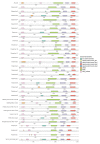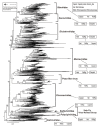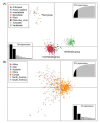The Husavirus Posa-Like Viruses in China, and a New Group of Picornavirales
- PMID: 32906743
- PMCID: PMC7551994
- DOI: 10.3390/v12090995
The Husavirus Posa-Like Viruses in China, and a New Group of Picornavirales
Abstract
Novel posa-like viral genomes were first identified in swine fecal samples using metagenomics and were designated as unclassified viruses in the order Picornavirales. In the present study, nine husavirus strains were identified in China. Their genomes share 94.1-99.9% similarity, and alignment of these nine husavirus strains identified 697 nucleotide polymorphism sites across their full-length genomes. These nine strains were directly clustered with the Husavirus 1 lineage, and their genomic arrangement showed similar characteristics. These posa-like viruses have undergone a complex evolutionary process, and have a wide geographic distribution, complex host spectrum, deep phylogenetic divergence, and diverse genomic organizations. The clade of posa-like viruses forms a single group, which is evolutionarily distinct from other known families and could represent a distinct family within the Picornavirales. The genomic arrangement of Picornavirales and the new posa-like viruses are different, whereas the posa-like viruses have genomic modules similar to the families Dicistroviridae and Marnaviridae. The present study provides valuable genetic evidence of husaviruses in China, and clarifies the phylogenetic dynamics and the evolutionary characteristics of Picornavirales.
Keywords: Picornavirales; evolution; husavirus; phylogeny; posa-like virus.
Conflict of interest statement
The authors declare no conflict of interest.
Figures





Similar articles
-
Phylogenetic analysis of novel posaviruses detected in feces of Japanese pigs with posaviruses and posa-like viruses of vertebrates and invertebrates.Arch Virol. 2019 Aug;164(8):2147-2151. doi: 10.1007/s00705-019-04289-8. Epub 2019 May 20. Arch Virol. 2019. PMID: 31111261
-
Characterization of Posa and Posa-like virus genomes in fecal samples from humans, pigs, rats, and bats collected from a single location in Vietnam.Virus Evol. 2017 Aug 23;3(2):vex022. doi: 10.1093/ve/vex022. eCollection 2017 Jul. Virus Evol. 2017. PMID: 28948041 Free PMC article.
-
Monsavirus in monkey rectal swab and throat swab specimens in China: Proposal for Posaliviridae as a new family in Picornavirales.Virus Res. 2021 Oct 2;303:198501. doi: 10.1016/j.virusres.2021.198501. Epub 2021 Jul 9. Virus Res. 2021. PMID: 34252491
-
Avian picornaviruses: molecular evolution, genome diversity and unusual genome features of a rapidly expanding group of viruses in birds.Infect Genet Evol. 2014 Dec;28:151-66. doi: 10.1016/j.meegid.2014.09.027. Epub 2014 Sep 30. Infect Genet Evol. 2014. PMID: 25278047 Review.
-
Picornaviridae-the ever-growing virus family.Arch Virol. 2018 Feb;163(2):299-317. doi: 10.1007/s00705-017-3614-8. Epub 2017 Oct 20. Arch Virol. 2018. PMID: 29058149 Review.
Cited by
-
Novel Virus Identification through Metagenomics: A Systematic Review.Life (Basel). 2022 Dec 7;12(12):2048. doi: 10.3390/life12122048. Life (Basel). 2022. PMID: 36556413 Free PMC article. Review.
-
Highly diverse ribonucleic acid viruses in the viromes of eukaryotic host species in Yunnan province, China.Front Microbiol. 2022 Oct 13;13:1019444. doi: 10.3389/fmicb.2022.1019444. eCollection 2022. Front Microbiol. 2022. PMID: 36312977 Free PMC article.
-
Special Issue "Emerging Viruses 2020: Surveillance, Prevention, Evolution and Control".Viruses. 2021 Feb 6;13(2):251. doi: 10.3390/v13020251. Viruses. 2021. PMID: 33562062 Free PMC article.
-
Genome of a husavirus from Southern Brazil.Rev Inst Med Trop Sao Paulo. 2023 Jan 16;65:e5. doi: 10.1590/S1678-9946202365005. eCollection 2023. Rev Inst Med Trop Sao Paulo. 2023. PMID: 36651466 Free PMC article.
-
Multiple clades of Husavirus in South America revealed by next generation sequencing.PLoS One. 2021 Mar 23;16(3):e0248486. doi: 10.1371/journal.pone.0248486. eCollection 2021. PLoS One. 2021. PMID: 33755700 Free PMC article.
References
-
- Adams M.J., Lefkowitz E.J., King A.M.Q., Harrach B., Harrison R.L., Knowles N.J., Kropinski A.M., Krupovic M., Kuhn J., Mushegian A., et al. Changes to taxonomy and the International Code of Virus Classification and Nomenclature ratified by the International Committee on Taxonomy of Viruses (2017) Arch. Virol. 2017;162:2505–2538. doi: 10.1007/s00705-017-3358-5. - DOI - PubMed
-
- Le Gall O., Christian P., Fauquet C.M., King A.M.Q., Knowles N.J., Nakashima N., Stanway G., Gorbalenya A.E. Picornavirales, a proposed order of positive-sense single-stranded RNA viruses with a pseudo-T = 3 virion architecture. Arch. Virol. 2008;153:715–727. doi: 10.1007/s00705-008-0041-x. - DOI - PubMed
Publication types
MeSH terms
LinkOut - more resources
Full Text Sources

